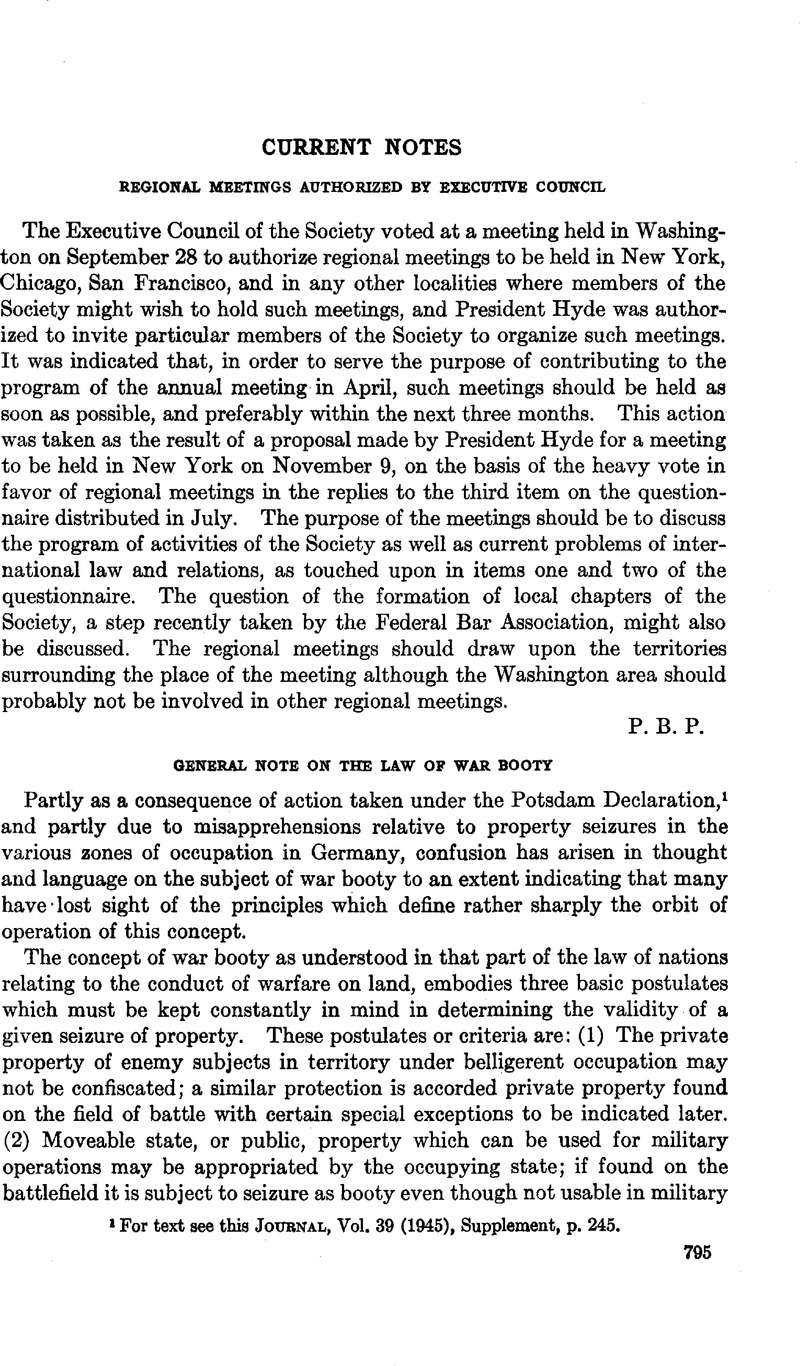Article contents
General Note on the Law of War Booty
Published online by Cambridge University Press: 20 April 2017
Abstract

- Type
- Current Notes
- Information
- Copyright
- Copyright © American Society of International Law 1946
References
1 For text see this Journal, Vol. 39 (1945), Supplement, p. 245.
2 See Oppenheim, , International Law, 6th ed., Vol. II, pp. 466-467 Google Scholar; Hall, , International Law, 8th ed., pp. 680-681 Google Scholar.
3 See Articles 42 and ff. of the Regulations annexed to Hague Convention No. IV of 1907, U. S. Treaty Series, No. 539; Malloy, Treaties, Vol. II, p. 2269; TM 27-251, Treaties Governing Land Warfare, p. 31 and ff.
4 A. V. Freeman, The International Responsibility of States for Denial of Justice, p. 515 and ff., and authorities cited.
5 Exchange of Notes between Mexico and the United States, August 22, 1938, this Journal, Vol. 32 (1938), p. 198.
6 See Kelsen, in this Journal, Vol. 38 (1944), p. 692, and his later discussion in same, Vol. 39 (1945), p. 518 and ff.
7 On March 1, 1946, the Department of State officially denied that the United States had any agreement with the Soviet Government in regard to “war booty” in Manchuria and repudiated any interpretation of that term to include industrial enterprises such as Japanese industries and equipment in Manchuria. Department of State Bulletin, Vol. XIV (1946), p. 364.
8 FM 27-10, Rules of Land Warfare, par. 313; and for an application of this principle in international jurisprudence, Hardman’s case, American and British Claims Arbitration, Nielsen’s Report, p. 495.
9 Such as under the “Liberated Areas Agreements” between the United States and various other governments, a typical example of which is the accord supplementing the agreement of May 16, 1944, between the United States and the Netherlands (official text unpublished).
10 A striking illustration of American policy is furnished by the American Government’s return to the Hungarian National Bank of approximately $32,000,000 worth of gold which had been removed from Hungary by the Germans and subsequently captured by the armed forces of the United States. See Department of State Bulletin, Vol. XV (1946), p. 335.
11 See Neel’s Executor v. Noland’s Heirs, 166 Ky. 455, 467.
12 Hyde, C. C., International Law, Boston, 1945 (2d ed.), Vol. II, § 694Google Scholar.
13 M. Huber, in Revue Générale de Droit International Public, 1913, p. 683; H. Rolin, Le Droit Moderne de la Guerre, § 547.
14 De Louter, J., Le Droit International Positif, Vol. II, p. 301 Google Scholar.
15 International Law, as cited pp. 310-311; also Hyde, § 695 and Spaight, Air Power and War Bights, p. 329.
16 A. Latifi, Effects of War on Property, p. 30.
17 Rolin, §§ 523, 528, and 530.
18 See Ferrand, Des Réquisitions en matière de Droit International Public, p. 176; Mérignhao, Le Droit des gens, et la Guerre de 1914-1918, Vol. III, p. 608.
19 Rolin, §530.
20 9 Recueil des Décisions des Tribunaux Arbitraux Mixtes, p. 67, at p. 72.
21 Morgan, ed., p. 160.
22 9 Recueil des Décisions des T.A.M. (1930), p. 195. And see Schwarzenberger, , International Law, Vol. I, p. 272 Google Scholar. In Mazzoni c. Finanze detto Stato, the court rejected an argument that stocks and bonds which had been left behind by their owners in Italian territory occupied by Austro-Hungarian troops, were liable to seizure as res nuUius or war booty: Annual Digest of Public International Law Cases, 1927-1928, Case No. 384; also G. H. Hack-worth, Digest, Vol. VI, p. 403.
23 Garner, J. W., International Law and the World War, Vol. II, pp. 130-131 Google Scholar; E. Feilchenfeld, The International Economic Law of Belligerent Occupation, p. 38.
24 Oppenheim, § 143a; and Garner, § 395.
25 Garner, §396, who points out that although Article 53 “allows, subject to restoration and indemnity for its use, the seizure of war material belonging to private persons, it does not authorize the seizure and exportation by the occupying belligerent of machinery and implements used in the industrial arts. “ See also note 7 above.
26 Work cited, § 397.
27 Rolin, § 555; Holland, Law of War on Land, par. 115.
28 Rivier, Principes de Droit des gens, Vol. II, p. 311; Mérignhac, Vol. III, p. 612.
29 Work cited, p. 54.
30 Revue Général de Droit International Public, 1913, p. 669. Accord: Von Stein, Le droit international des chemins defer en temps de guerre in Revue de droit international et de législation comparée, Vol. 17, 1885, pp. 543 and ff.
31 Scott, J. B., ed., Proceedings of the Hague Peace Conference of 1899, p. 67.
32 Westlake, , International Law, Vol. II, p. 114 Google Scholar; Huber, work cited, pp. 664, 665.
33 Hershey, , The Essentials of Public International Law, p. 620 Google Scholar; Bordwell, The Law of War, p. 324; Huber, work cited, pp. 664, 669, 670.
34 One of the primary difficulties with the Potsdam provisions on reparations is that no attempt was made to distinguish between external assets which were properly German, and those which had been seized wrongfully by the Germans from other nations during the war. For example, when the Nazis invaded Austria they appropriated most of the capital equipment of that country. At Potsdam it was provided that Soviet reparations claims were to be met by removals from the Soviet zone and “from appropriate German external assets” (IV, 1). Coupled with this was a renunciation by the United Kingdom and the United States of all claims “to German foreign assets in . . . Eastern Austria” (IV, 9). Under this language the Soviet Government has sought to justify its seizure—as German external assets—of property stolen from the Austrians by Germany. More meticulous draftsmanship might possibly have avoided both a serious source of friction and the resultant injustice to Austria. See this Journal, Vol. 39 (1945), Supplement, p. 245, at pp. 251-253.
35 Same, p. 252.
- 3
- Cited by




